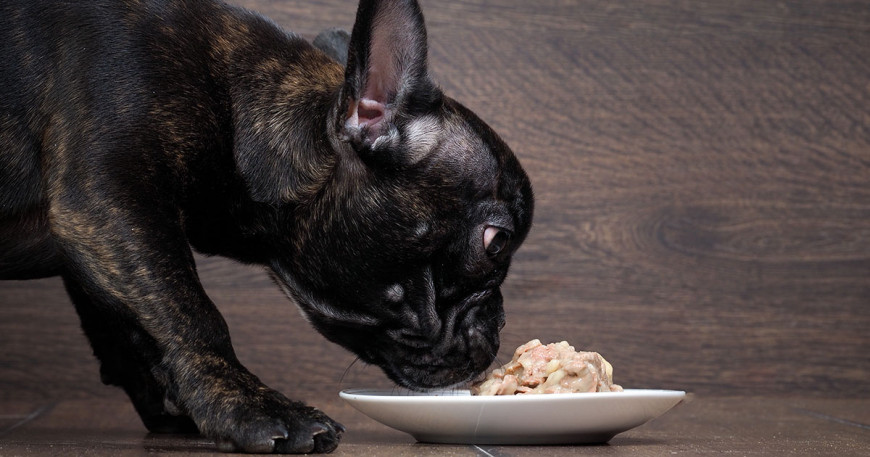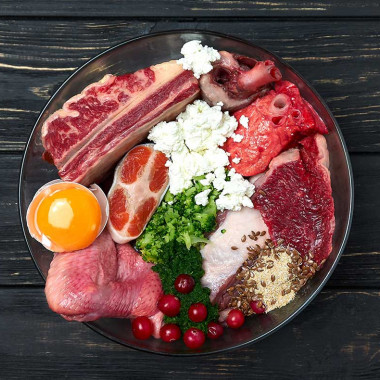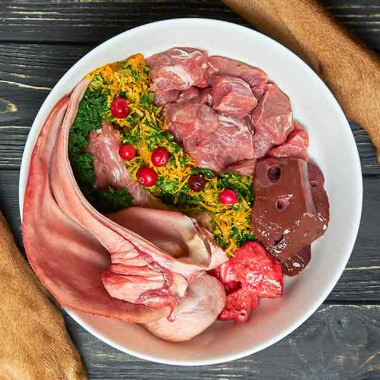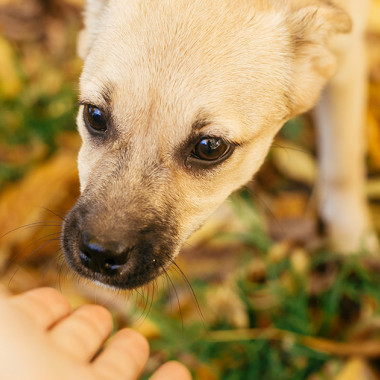The optimal period for a puppy to leave its mother and move to a new home is after 8 weeks from birth. Until then, the puppy should stay with its mother. Although the puppy may start eating solid food earlier, from a psychological perspective, it should remain in its original home. The mother helps with the puppy’s upbringing and sets boundaries for play. Puppies taken away from their mothers too early are often hyperactive, disobedient, and may not tolerate other dogs.
If you are considering breeding and producing quality puppies, or if your female dog is pregnant and you want to feed the puppies BARF from the beginning, this article will help you.
Right after birth, the puppies should drink colostrum as soon as possible. Colostrum is the secretion from the mammary glands that is produced only for a few days after birth and gradually transitions into milk. Colostrum is thicker, has a high content of immunoglobulins, vitamins, minerals, and proteins, providing the puppy with passive immunity for several weeks. It is important that the puppy receives enough colostrum as soon as possible after birth. Otherwise, the transfer of immunoglobulins through the intestinal wall into the puppy’s bloodstream will not occur, meaning the puppy won’t have enough immune protection and may be more susceptible to diseases throughout its life.
Feeding in the 1st and 2nd Week of the Puppy’s Life
During the first two weeks, puppies only consume their mother’s milk. It is important to monitor whether the mother has enough milk or if there are too many puppies. Therefore, it’s crucial to provide the mother with quality food and a peaceful environment for nursing.
How to Supplement the Puppies
You can start supplementing the puppies from the 3rd week of age, 1-2 times a day. Milk remains very important for puppies, but since cow's milk is harder for dogs to digest, goat’s milk is a better option. Prepare a mash for the puppies from goat’s milk, meat, and grated carrots. Chicken and turkey breasts are the most suitable as they are easily digestible. At first, you can lightly cook them in plain water, grind them, and mix them with the carrots and goat’s milk, or raw egg yolk. Meat should make up 80%, and vegetables 20% of the meal. Always serve the mash warm, ideally at 38°C. A 3-week-old puppy has difficulty moving, so you should help them get used to the mash by dipping their mouth in it or trying to feed them with your finger.
How Often to Feed the Puppy
From the 4th week, you can supplement the puppies 2-3 times a day. The meal should resemble that of the 3rd week, but the meat no longer needs to be cooked. However, it should still be warmed to prevent the puppies from getting cold. You can start adding beef to the puppies’ meals. If the mother regurgitates food for the puppies, it is normal, and you don’t need to stop her.
5-Week-Old Puppy
From the 5th week, you can add ground chicken wings, carcasses, necks, dairy products, poultry stomachs, hearts, leafy greens, apples, bananas, kiwis, oats, and other types of meat to the puppy’s meal. At 5 weeks, supplementing 3 times a day is sufficient. For larger breeds, you can start cutting the meat into small cubes so the puppy won’t have trouble eating whole pieces later.
What to Feed a 6-Week-Old Puppy
A 6-week-old puppy's meal should resemble that of an adult dog. It can include various types of meat, bones, vegetables, fruits, and supplements, as well as lean offal. For small breeds, it’s still better to provide ground bones, while for larger breeds, you can chop them into smaller pieces. It is also appropriate to start giving them pangamin and seaweed. Supplement the puppy’s diet 4 times a day.
7-Week-Old Puppy’s Meal
At this age, puppies may still drink their mother’s milk occasionally, but they should be supplemented at least 6 times a day. Larger breeds are already capable of eating whole bones. The puppy’s bowl can include all types of meat, vegetables, fruits, and supplements to ensure a varied diet. If the puppy is going to a new home where they will be fed kibble, it’s better to start preparing them for it by the 7th week. The kibble should be of high quality and soaked in meat broth, water, or goat’s milk before feeding. It is best to serve it in the evening.
Daily Food Intake for a Puppy
From the 8th week, puppies are ready to go to their new homes. However, new owners should be informed on how to feed raw food even in the new environment. Ideally, you should provide them with packets of the meals the puppy is used to. The amount of food should be 4-6% of the puppy’s ideal weight. This amount should be divided into parts, with 50% being meat, 30% bones, and 20% supplements. The puppy should be fed at least 5-6 times a day. This means dividing the total daily portion into 5-6 meals and feeding the puppy throughout the day. The meal should be at least at room temperature, but ideally 38°C.
If you’ve decided to feed your puppies natural food from birth, we are very happy and hope this article has helped you.










